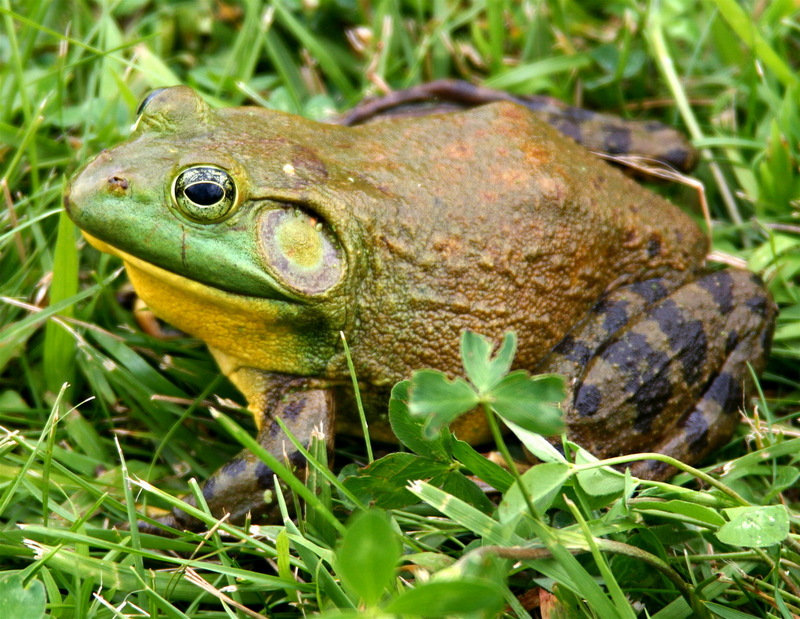|
| Query: Southern green frog | Result: 12th of 43 | |
American Bullfrog (Lithobates catesbeianus) - Wiki
| Subject: | American Bullfrog (Lithobates catesbeianus) - Wiki
| |

| Resolution: 1144x885
File Size: 460710 Bytes
Date: 2004:08:01 14:50:17
Camera: Canon EOS DIGITAL REBEL (Canon)
F number: f/5.6
Exposure: 1/320 sec
Focal Length: 135/1
Upload Date: 2007:08:14 14:53:02
|
Bullfrog
From Wikipedia, the free encyclopedia
[Photo] North American bullfrog (Rana catesbeiana), Photographer: Carl D. Howe http://en.wikipedia.org/wiki/User:Cdhowe; Location: Stow, MA USA; Date of photograph: August 1, 2004
The American Bullfrog (Lithobates catesbeianus, previously Rana catesbeiana) is an aquatic frog, a member of the family Ranidae, or "true frogs", native to much of North America.
Physical description
The bullfrog is a large species of the Ranidae family and can grow to a length of 6 inches (15 cm) with a weight of up to 1.5 lb (750 g). Females are typically larger than males. They are generally varying shades of green or brown, with dark brown, dark green, or black blotching and a yellow or white underside.
The skeleton of an adult frog consists of bone, hyaline cartilage, and calcified cartilage. The calcified cartilage can be found throughout the body of the frog, but it is particularly more noticeable in the epiphyses of the long bones in the limbs and shoulder-gridle. The frog has no scapula and a suprascapula which allows for greater range of motion for long jumps. The radius and ulna have become fused into a single bone, the radio-ulna, and the tibia and fibula have become fused into a single bone, the tibio-fibula.
The vertebrae comprise ten bones; nine are true vertebrae, and the rod-shaped urostyle that is almost as long as the other nine. The head of the frog is flat but its form depends on the extensive separation of the jaw bones; the orbital cavities and the horizontal direction of their floor also have an effect on the form of the head of the balls. The central nervous system is made up of the spinal cord and the brain, where the spinal cord is a bit smaller than the brain. The peripheral nervous system contains the cranial nerves and spinal nerves.
Ecology and behavior
The American Bullfrog uses its skin, buccal cavity, and lungs for respiration. Cutaneous ("skin") gas exchange is very important in all amphibians. They are aptly named since their call is a loud, guttural bellow that carries a long distance, giving the impression that the frog is much larger than it actually is, which is an advantage in keeping predators away.
Reproduction
The male reproductive organs are the testes and their duct, and the female have ovaries. In the spring the male calls the female from the water. The female lays up to 25,000 eggs, and these eggs become tadpoles. Their metamorphosis brings them the organs that are only found in the adult frogs and takes between 12-24 months. There are three major changes that take place during the metamorphosis:
1. Premetamorphisis which is when the embryo genesis and growth and development occur, during this time the thyroid gland is absent.
2. Prometamorphisis is the period in which the concentration of the endogenous thyroid hormone rises.
3. Metamorphosis is the period when the tadpole's tail shrinks back into the frog's body. Other organs also undergo changes such as the liver and the intestine. The gills are absorbed as well.
The adult frog can live up to 13 years.
Distribution
The American Bullfrog is native to North America. They are found in the United States, Canada and Mexico, east of the Rocky Mountains, but have been introduced to many other localities throughout the world. In Europe and the western U.S., measures are often taken to control its spread because it competes with, and often drives out, native species.
Human use
While occasionally kept as pets, the American Bullfrog provides a minor food source, especially in the Southern United States and in some areas of the Midwestern United States. In a few locations they are commercially cultured in ponds, but the traditional way of hunting them is to paddle or pole silently by canoe or flatboat in streams or swamps at night; when the frog call is heard, a light is shined on the frog to temporarily inhibit it. The frog will not jump into deeper water as long as movement is slow and steady. When close enough, the frog is gigged and brought into the boat. The only parts eaten are the rear legs, which resemble small chicken drumsticks and, sometimes, the backs, and they are usually fried for consumption.
The American Bullfrog is also used as a specimen for dissection in many schools across the world.
Trivia
The American Bullfrog is the State Amphibian of Missouri and Oklahoma.
Two Bullfrogs were launched into orbit in 1970 on the Orbiting Frog Otolith spacecraft.
http://en.wikipedia.org/wiki/Bullfrog
| The text in this page is based on the copyrighted Wikipedia article shown in above URL. It is used under the GNU Free Documentation License. You may redistribute it, verbatim or modified, providing that you comply with the terms of the GFDL. |
|
Comments |
|---|
| | Pharma969 |
|
| Hello! gggfbdb interesting gggfbdb site! |
| | Pharmg350 |
|
| Very nice site! |
^o^
Animal Pictures Archive for smart phones
^o^
|
|
|

